We may not have the course you’re looking for. If you enquire or give us a call on 01344203999 and speak to our training experts, we may still be able to help with your training requirements.
We ensure quality, budget-alignment, and timely delivery by our expert instructors.
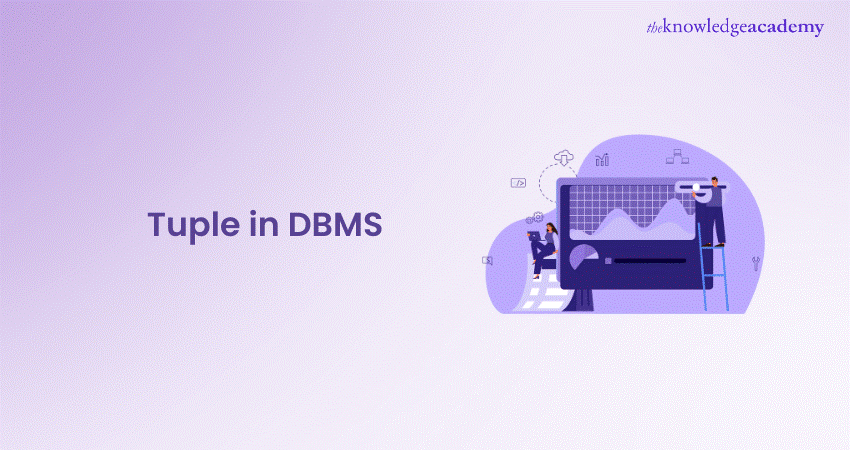
Ever pondered how databases manage to keep vast oceans of Data neatly organised and effortlessly accessible? Picture this: a bustling library where every book is perfectly placed on its shelf, making it a breeze to find exactly what you need. In the realm of Database Management Systems (DBMS), organisational magic is powered by a humble yet crucial concept - the Tuple in DBMS.
As we explore further, you'll see how tuples do more than just store data. They are key to ensuring consistency and efficiency in databases, making it easier to handle even the most complex data sets. Ready to discover how the Tuple in DBMS transforms Data Management? Let’s dive in!
Table of Contents
1) What is Tuple in DBMS?
2) Different Types of Tuples in DBMS
3) How to Work with Tuple in DBMS?
4) Key Features of Tuples in DBMS
5) Drawbacks of Tuple in DBMS
6) Conclusion
What is Tuple in DBMS?
In DBMS terminology, a tuple is a single row in a table. It represents a single, data entity that adheres to the schema of the table. Each tuple consists of a set of attribute values, corresponding to the columns of the table. Essentially, a tuple is a collection of related data items that together make up one record within a database.
For instance, in a table named Employees, a tuple may represent the data of an individual employee, including fields such as Employee ID, Name, Position, and Salary. While exploring types of attributes in DBMS, it’s clear that each tuple provides values for these fields, creating a comprehensive record of the employee.
Different Types of Tuples in DBMS
Following are the different types of tuples in a Database Management System:
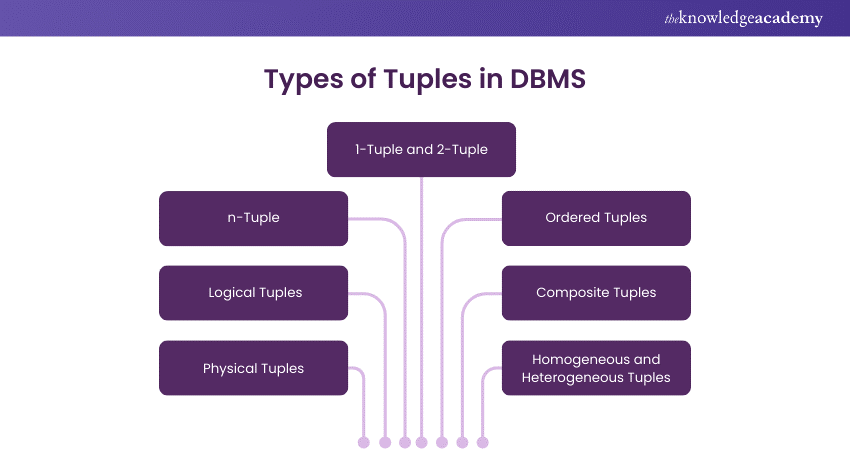
1) Physical Tuples:
a) Physical tuples are the actual representations of data stored on the storage medium of a database, such as hard drives or solid-state drives.
b) They are referred to as records or rows and contain all the necessary data corresponding to a specific row in a table.
c) For example, in a table named Employees, a tuple might represent a single employee’s data, including fields like Employee ID, Name, Position, and Salary. Each tuple provides the values for these fields, forming a complete record of the Entity in DBMS.
2) Logical Tuples:
a) Logical tuples represent data in memory, abstracted from the physical representation. They exist temporarily during query operations or data processing.
b) These tuples may not hold all attributes or might have simplified data representations for ease of access during transactions.
c) For instance, when querying specific fields of a record (like just Name and Salary), the resulting data structure in memory can be viewed as logical tuples.
3) n-Tuple:
An n-tuple is a general term representing a tuple with 'n' elements. For instance, a 3-tuple might look like (ID, Name, Age) but could be extended further.
4) 1-Tuple and 2-Tuple:
A 1-tuple contains a single value (e.g., (123)), while a 2-tuple contains two values (e.g., (123, 'Alice')).
5) Ordered Tuples:
The order of elements is crucial; swapping elements can change the meaning entirely (e.g., (Name, Age) is different from (Age, Name)).
6) Composite Tuples:
These include tuples within tuples. For example, a tuple for a person might include an address tuple (street, city, zip) as one of its elements.
7) Homogeneous and Heterogeneous Tuples:
Homogeneous tuples consist of similar data types (e.g., all integers). At the same time, heterogeneous tuples contain different types (e.g., integers, strings, and real numbers) within the same tuple.
Master NoSQL with expert Introduction To NoSQL Course - start your journey today and revolutionise your Data Management skills!
How to Work with Tuple in DBMS?
Here’s how to work with a Tuple in DBMS, offering essential techniques for handling tuples and transforming your Data Management skills.
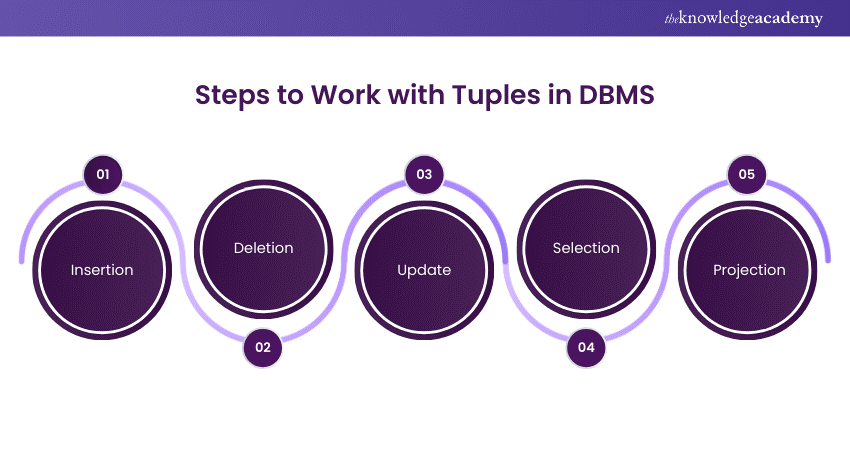
1) Insertion:
Adding a new tuple to a table involves specifying the values for each attribute in the tuple. This is typically done using the INSERT statement in SQL.
2) Deletion:
Removing an existing tuple from a table is done using the DELETE statement. You need to specify the condition that identifies which tuple(s) to remove.
3) Update:
Modifying the values of an existing tuple is achieved using the UPDATE statement. You specify the new values and the condition to identify which tuple(s) to update.
4) Selection:
Retrieving specific tuples based on certain criteria is done using the SELECT statement. You can specify conditions to filter the tuples you want to retrieve.
5) Projection:
Retrieving specific attributes of tuples involves selecting only the columns you are interested in. This is also done using the SELECT statement, but you specify the columns instead of using *.
Example:
|
-- Create the Employees table CREATE TABLE Employees ( EmployeeID INT PRIMARY KEY, Name VARCHAR(100), Position VARCHAR(50), Salary DECIMAL(10, 2) ); -- Insert a new tuple into the Employees table INSERT INTO Employees (EmployeeID, Name, Position, Salary) VALUES (1, 'John Doe', 'Software Engineer', 60000.00); -- Select all tuples from the Employees table SELECT * FROM Employees; -- Update the Salary of the employee with EmployeeID 1 UPDATE Employees SET Salary = 65000.00 WHERE EmployeeID = 1; -- Select the updated tuple to verify the change SELECT * FROM Employees WHERE EmployeeID = 1; -- Delete the tuple with EmployeeID 1 DELETE FROM Employees WHERE EmployeeID = 1; -- Verify deletion by selecting all tuples SELECT * FROM Employees; |
Output:

Explanation:
1) Creating a Table: Defines the structure of the Employees table
2) Inserting a Tuple: Adds a record into the table
3) Selecting Tuples: Retrieves all records from the table
4) Updating a Tuple: Modifies an existing record
5) Verifying the Update: Checks the changes made
6) Deleting a Tuple: Removes a record from the table
7) Verifying Deletion: Confirms that the record has been deleted
Master database integration and build cutting-edge applications with our GraphQL Database Training With React Course – sign up today!
Key Features of Tuples in DBMS
Here are the key features of tuples in a Database Management System:
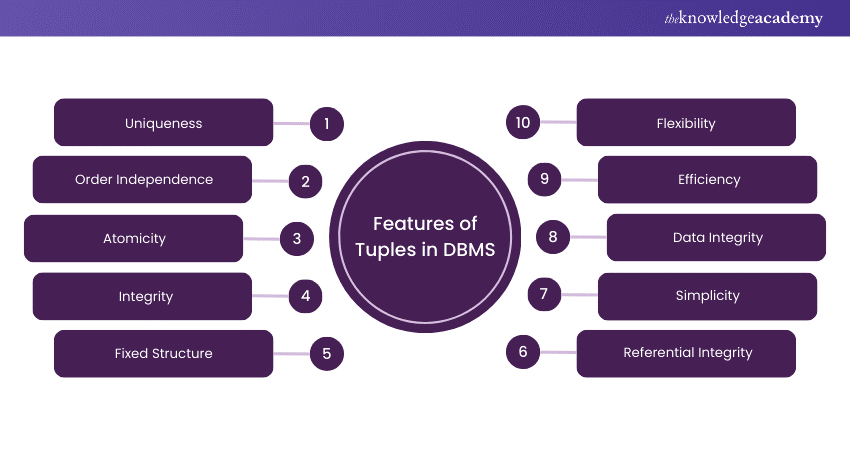
1) Uniqueness:
Each tuple in a table is unique. This means that no two tuples in a table can have the same set of values for all attributes. This uniqueness is often enforced using primary keys.
2) Order Independence:
The order of tuples in a table does not affect the database operations. This means that tuples can be stored and retrieved in any order without impacting the integrity or functionality of the database.
3) Atomicity:
Each attribute in a tuple is atomic, meaning it cannot be divided further. This ensures that each piece of data is stored in its simplest form, which helps maintain data integrity and simplifies data manipulation.
4) Integrity:
Tuples maintain data integrity through constraints like primary keys, foreign keys, and unique constraints. These constraints ensure that the data remains accurate and consistent across the database.
5) Fixed Structure:
Tuples have a fixed structure, meaning that the number and type of attributes are defined by the table schema. This ensures that each tuple in a table has the same structure, which simplifies Data Management and querying.
6) Flexibility:
Tuples can represent complex data structures through nested and composite tuples. This allows for the representation of hierarchical and multi-dimensional data within a relational database.
7) Efficiency:
Operations on tuples, such as insertion, deletion, and updates, are generally efficient and straightforward. This efficiency is crucial for maintaining performance in large databases.
8) Data Integrity:
Tuples help maintain data integrity by ensuring that each record adheres to the defined schema and constraints. This prevents invalid data from being entered into the database.
9) Simplicity:
Tuples provide a simple and intuitive way to represent data. Each tuple corresponds to a single record, making it easy to understand and work with the data.
10) Referential Integrity:
Tuples support referential integrity through foreign keys, which ensure that relationships between tables are maintained. This prevents orphan records and maintains the consistency of the database.
Discover the power of SQL Databases - join our Introduction To SQL Databases Training 10985C and propel your data skills forward!
Drawbacks of Tuple in DBMS
Let’s explore the drawbacks of Tuple in DBMS:
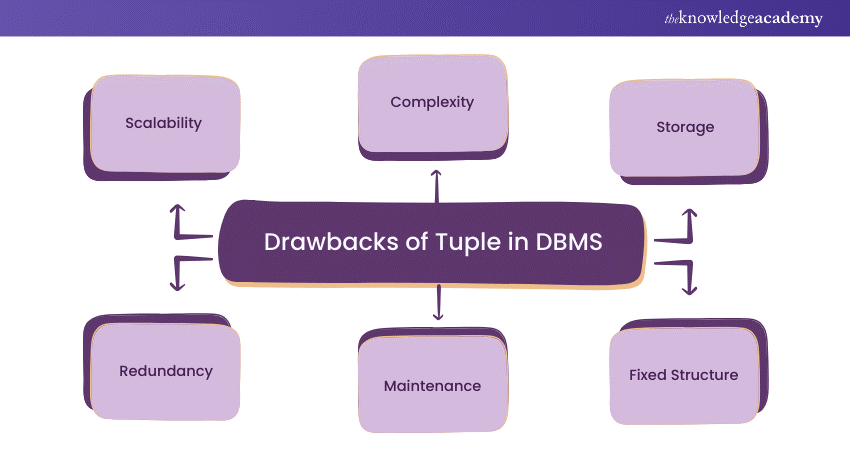
a) Scalability: Managing a large number of tuples can impact performance and require optimisation.
b) Complexity: Nested and composite tuples can complicate data retrieval and require advanced querying.
c) Storage: Large tuples with many attributes can consume significant storage space.
d) Fixed Structure: A fixed schema limits flexibility for dynamic data requirements.
e) Maintenance: Ensuring data integrity across numerous tuples demands significant maintenance.
f) Redundancy: Repeated data in multiple tuples can increase storage needs and complicate data management.
Achieve database excellence with our top-rated Database Training - sign up now to gain essential skills and knowledge!
Conclusion
The Tuple in DBMS is essential for maintaining structured and efficient Data Management. By representing individual records with related data values, tuples ensure consistency and accessibility within relational databases. Understanding their role helps optimise database performance and reliability, making them vital for effective data handling.
Transform your understanding of databases with our expert-led Introduction To Database Training – join now and boost your career!
Frequently Asked Questions
What is the Importance of Tuple in Database?

Tuples are crucial in databases as they represent individual records. They ensure data consistency, enable efficient retrieval and facilitate operations by aligning with the table's schema and structure.
What is a Tuple Also Known as?

A tuple is also known as a record or row in a database table. It represents a single, complete data entity composed of attributes corresponding to the table’s columns.
What are the Other Resources and Offers Provided by The Knowledge Academy?

The Knowledge Academy takes global learning to new heights, offering over 30,000 online courses across 490+ locations in 220 countries. This expansive reach ensures accessibility and convenience for learners worldwide.
Alongside our diverse Online Course Catalogue, encompassing 19 major categories, we go the extra mile by providing a plethora of free educational Online Resources like News updates, Blogs, videos, webinars, and interview questions. Tailoring learning experiences further, professionals can maximise value with customisable Course Bundles of TKA.
What is The Knowledge Pass, and How Does it Work?

The Knowledge Academy’s Knowledge Pass, a prepaid voucher, adds another layer of flexibility, allowing course bookings over a 12-month period. Join us on a journey where education knows no bounds.
What are the Related Courses and Blogs Provided by The Knowledge Academy?

The Knowledge Academy offers various Database Training, including Introduction to Database Training, Relational Databases & Data Modelling Training and Introduction to NoSQL Course. These courses cater to different skill levels, providing comprehensive insights into Decomposition in DBMS.
Our Programming & DevOps Blogs cover a range of topics related to Database Management Systems, offering valuable resources, best practices, and industry insights. Whether you are a beginner or looking to advance your Programming skills, The Knowledge Academy's diverse courses and informative blogs have got you covered.
Upcoming Programming & DevOps Resources Batches & Dates
Date
 Introduction to Database Training
Introduction to Database Training
Fri 25th Apr 2025
Fri 20th Jun 2025
Fri 22nd Aug 2025
Fri 17th Oct 2025
Fri 19th Dec 2025






 Top Rated Course
Top Rated Course



 If you wish to make any changes to your course, please
If you wish to make any changes to your course, please


